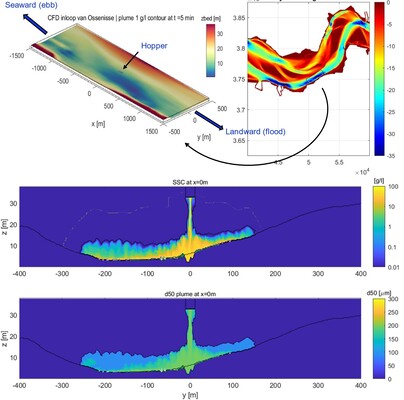J.M. Boersma*1, L. de Wit1 , C. Jeuken1
1 Deltares, the Netherlands;
* Corresponding author: jan.boersma@deltares.nl
Introduction
The Western Scheldt estuary in southwest Netherlands provides access to the port of Antwerp via a main navigation channel. Sediment dredged from the fairway is placed in designated areas, including deep placement sites in the main channel. Key questions about the efficiency and effectiveness of these sediment placements remain, particularly regarding the integration of disposed sediment into the natural morphological system. Data analysis and modeling have been used to seek answers, but it is unclear if regular process models accurately capture sediment dynamics, especially during and shortly after the placement. This study investigates the benefits of using Computational Fluid Dynamics (CFD) modeling. Previous research (IMDC 2020) compared CFD with test placement measurements. This study includes previously unconsidered processes: multi-fraction sediment use (to simulate spatial segregation of coarse and fine sediment during placement), sediment deposition on the estuary bottom (to determine sediment transport by density currents before settling), and sediment erosion from the bottom back into the water column (to simulate resuspension and integration). The focus is on sediment behavior during and shortly after placement, examining sediment retention in the placement area, and the roles of segregation and resuspension in near-field transport over a tidal cycle.
Objective and Methods
A CFD model was set up for the Inloop van Ossenisse (Western Scheldt) for several flow conditions in a tidal cycle. The CFD simulations were performed using open-source software (TUDflow3D). TUDflow3D is specifically developed for detailed simulations of dredging processes and can handle multi-fraction sediment, density currents, turbulent mixing, and morphological bottom development with feedback to the turbulent flow. TUDflow3D has been successfully applied in studies and publications on dredging plumes from trailing suction hopper dredgers, density currents, channel flow with very high sand concentrations, erosion pit development around monopiles and jackets, (Alhaddad 2020, De Wit 2014, 2015), and many other situations.
Results
The simulations provide important insights. Within the first five minutes, the sediment spreads several hundred meters around the placement site, in a zone approximately 400 meters wide across the current. Under the hopper, a significant erosion pit forms of about 40% of the placed volume. This stirred-up sediment is incorporated into the density current, contributing to the range and settling of sediment in the area. Segregation and resuspension play a crucial role in near-field transport. From half an hour after the placement, spatial segregation becomes the determining factor for the moving sediment. The dynamics vary throughout the tidal cycle, with sediment settling at slack water and resuspending during rising tide. Using multiple sediment fractions in the simulations leads to different outcomes compared to using just one fraction (D50). This difference is especially evident in stronger currents, where the D50 fraction underestimates total deposition within the first 500 meters and overestimates it further from the source. These findings can contribute to improved boundary conditions for sediment placements in a large-scale sediment transport model and are applicable to other locations with similar depth and current profiles as the Inlet of Ossenisse.

Top: Overview of the location, extent, and bathymetry of the Inloop van Ossenisse as used for the simulations. Bottom: Color plot of suspended sediment concentrations and sediment D50 in the cross-sectional profile (y-z) immediately after placement during slackwater.
References
Alhaddad, S., de Wit, L., Labeur, R.J., Uijttewaal, W. J., 2020. Modeling of Breaching-Generated Turbidity Currents Using Large Eddy Simulation. Mar. Sci. Eng.
Wit L. de & Van Rhee C., 2014a. Testing an Improved Artificial Viscosity Advection Scheme to Minimise Wiggles in Large Eddy Simulation of Buoyant Jet in Crossflow. Flow, Turbulence and Combustion, 92 (3).
Wit, L. de, A.M. Talmon and C. van Rhee, 2014b. 3D CFD simulations of trailing suction hopper dredger plume mixing: a parameter study of near field conditions influencing the suspended sediment source flux, Marine Pollution Bulletin.
Wit L. de, 2015. 3D CFD modelling of overflow dredging plumes. Ph.D. Thesis, University of Technology, Delft.
IMDC (2020). Report on CFD calculations disposal plumes. I/RA/12161/20.005/BDC/FKY.










